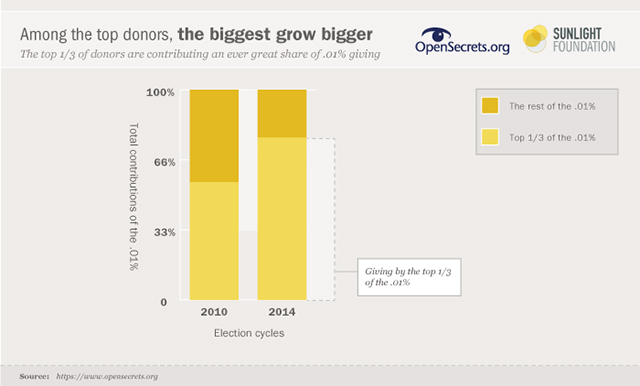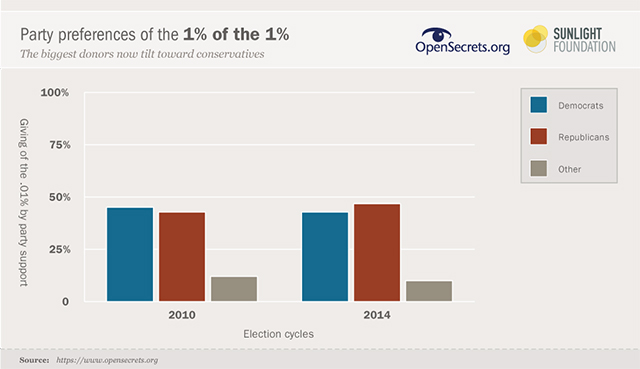
One lesson of the 2014 election cycle was that more money came from fewer people.
And a look at the political One Percent of the One Percent of Americans — the top 31,000 or so donors, roughly equal to one percent of one percent of the U.S. population — over the last three elections bears that out: The money coming from this select demographic is increasing and it is leaning more conservative. What’s more, even within the top .01 percent, the donors at the very peak are contributing more and more of the money.
The Center for Responsive Politics and the Sunlight Foundation teamed up to take a detailed look at the topmost tier of donors of disclosed political contributions at the federal level.
 This report is a joint project of the Center for Responsive Politics and the Sunlight Foundation.
This report is a joint project of the Center for Responsive Politics and the Sunlight Foundation.Among the findings: In 2014, the top .01 percent accounted for just more than $1 billion worth of donations, up from $732.7 million in the previous midterm in 2010. The 61 percent increase far exceeds the rate of inflation or the increase in the election‘s total cost, meaning this top group of donors assumed a far greater role in financing the most recent election than the previous midterm. According to OpenSecrets.org data, all donors in the 2010 election gave roughly $3.48 billion, of which the top 32,000 or so paid for about 20 percent. In 2014, all donors chipped in $4.01 billion; the top One Percent of the One Percenters accounted for about 28.6 percent of that.
Even among the top .01 percent, there is a perceptible trend toward the biggest donors shouldering more and more of the cost.
In 2010, it took at least $8,200 in donations reported to the Federal Election Commission to land in this exalted club. In 2014, the entry fee was $8,810 — an increase smaller than the rate of inflation, meaning that it was easier to get into the top .01 percent in 2014. Similarly, the median donation from this group in 2010 was $13,500, while in 2014 it was up to $14,850 – not a dramatic hike. Yet the top .01 percent gave $447 million more in 2014.
As it turns out, the most generous donors among the top 32,000 or so who make up the .01 percent gave more in 2014 than in 2010. The median donation for the top third of this group — roughly 10,400 donors each cycle — in 2014 was $37,600, up $5,100 from the same group in 2010. In 2010, that group of top 10,400 or so donors gave $488.4 million, or about 56 percent of the total donated by the .01 percent. By 2014, the top 10,400 donors gave nearly twice as much — $911.1 million, or roughly 86.5 percent of the donations from the larger group.
Even within the top .01 percent, there is apparently an elite set of donors pulling away from the pack.

Partisan skewing
The .01 percent includes wealthy individuals from both ends of the political spectrum, but there are relatively few in between and the numbers at the extremes are growing. And more money is coming from the right.
The vast majority of donors in this demographic gave overwhelmingly, if not entirely, to one side or the other.
In 2010, there were 12,178 donors in the .01 percent who gave no money to Democratic or liberal recipients at the federal level, and a similar 12,782 who gave no money to Republican or conservative causes. In 2012, a presidential year, there were suddenly 14,672 donors who gave to no Democratic or liberal recipients, and only 10,672 who gave to no Republican or conservative ones.
By 2014, the trend toward greater partisanship had solidified, though the conservatives dominated — a full 15,147 (or almost half of the .01 percent) gave no money to Democrats or liberals, while 13,333 gave nothing to any Republicans or conservatives. There were just 174 donors among the 32,000 in 2014 who gave equally to both sides — one less than in 2010. And the biggest donor who gave to both sides in 2014 was only the 980th largest donor overall. The big money clearly lands on the extremes of the spectrum.
Overall, donations from the top donors numbering .01 percent of the population have moved from favoring Democrats and liberals to favoring Republicans and conservatives.
In 2010, 45.1 percent of donations from this set went to Democratic or liberal recipients, more than the 42.7 percent that went to Republican or conservative recipients. In 2012, the equation changed dramatically, with just 36.5 percent of the group’s money going to the left and 59.7 percent going to the right. By 2014, the .01 percent were slightly more interested in liberal recipients than they’d been in the presidential cycle, but not much — 42.7 percent of donations from these elite donors went to liberals while 46.8 percent went to conservatives, almost exactly flipped from the picture in 2010.

Our most important fundraising appeal of the year
December is the most critical time of year for Truthout, because our nonprofit news is funded almost entirely by individual donations from readers like you. So before you navigate away, we ask that you take just a second to support Truthout with a tax-deductible donation.
This year is a little different. We are up against a far-reaching, wide-scale attack on press freedom coming from the Trump administration. 2025 was a year of frightening censorship, news industry corporate consolidation, and worsening financial conditions for progressive nonprofits across the board.
We can only resist Trump’s agenda by cultivating a strong base of support. The right-wing mediasphere is funded comfortably by billionaire owners and venture capitalist philanthropists. At Truthout, we have you.
We’ve set an ambitious target for our year-end campaign — a goal of $225,000 to keep up our fight against authoritarianism in 2026. Please take a meaningful action in this fight: make a one-time or monthly donation to Truthout before December 31. If you have the means, please dig deep.